Cincinnati Zoo and Botanical Garden
The Cincinnati Zoo & Botanical Garden is the sixth-oldest zoo in the United States, opening in 1873, after the Roger Williams Park Zoo (1872). It is located in the Avondale neighborhood of Cincinnati, Ohio. It originally began with 64.5 acres (26.5 ha) in the middle of the city, but has spread into the neighboring blocks and several reserves in Cincinnati's outer suburbs. It was appointed as a National Historic Landmark in 1987.[1][5]
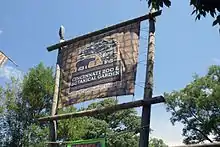 | |
| Date opened | 1875[1] |
|---|---|
| Location | 3400 Vine St, Cincinnati, Ohio, U.S. |
| Coordinates | 39.145°N 84.508°W |
| Land area | 75 acres (30 ha)[2] |
| No. of animals | 1,896 |
| No. of species | 500+[1] |
| Annual visitors | 1.2 million+[1] |
| Memberships | AZA,[3] WAZA[4] |
| Website | cincinnatizoo |
The zoo houses over 500 animals and 3,000 plant species. In addition, the zoo also has conducted several breeding programs in its history, and was the first to successfully breed California sea lions. In 1986, the Lindner Center for Conservation and Research of Endangered Wildlife (CREW) was created to further the zoo's goal of conservation.[1] The zoo is known for being the home of Martha, the last living passenger pigeon,[5] and to Incas, the last living Carolina parakeet.[6]
The zoo is an accredited member of the Association of Zoos and Aquariums (AZA),[3] and a member of the World Association of Zoos and Aquariums (WAZA).[4]
A 2014 ranking of the nations's best zoos by USA Today based on data provided by the Association of Zoos and Aquariums lists the Cincinnati Zoo among the best in the country.[7] A 2019 reader's choice ranking of the nation's best zoos by USA Today named the Cincinnati Zoo the top zoo in North America.[8]
History
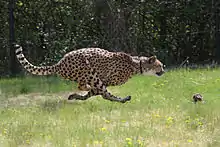
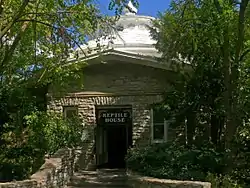
In 1872, three years before the zoo's creation, Andrew Erkenbrecher and several other residents created the Society for the Acclimatization of Birds in Cincinnati to acquire insect-eating birds to control a severe outbreak of caterpillars. A collection of approximately 1,000 birds imported from Europe in 1872 was housed in Burnet Woods before being released. In 1873, members of the Society of Acclimatization began discussing the idea of starting a zoo and founded The Zoological Society of Cincinnati.[9] One year later, the Zoological Society of Cincinnati purchased a 99-year lease on sixty-five acres in the cow pasture known as Blakely Woods.[10]
The Cincinnati Zoological Gardens officially opened its doors on September 18, 1875. Architect James W. McLaughlin, who constructed the zoo's first buildings, designed the earliest completed zoological exhibits in the United States.[11] The zoo began with eight monkeys, two grizzly bears, three white-tailed deer, six raccoons, two elk, a buffalo, a laughing hyena, a tiger, an American alligator, a circus elephant, and over four hundred birds, including a talking crow.[1] The first guide book about the Cincinnati Zoo was written in 1876 in German. The founders of the zoo, including its first general manager, were German immigrants and the city had quite a large German-speaking population. The first English-language edition (illustrated) was published in 1893.[12]
In its first 20 years, the zoo experienced many financial difficulties, and despite selling 22 acres (8.9 ha) to pay off debt in 1886, it went into receivership in 1898. In order to prevent the zoo from being liquidated, the stockholders chose to give up their interests of the $225,000 they originally invested.[9] For the next two years, the zoo was run under the Cincinnati Zoological Company as a business. In 1901, the Cincinnati Traction Company, purchased the zoo, hoping to use it as a way to market itself to potential customers.[13] They operated the zoo until 1917, when the Cincinnati Zoological Park Association, funded by donations from philanthropists Mary Emery and Anna Sinton Taft and a wave of public desire to purchase the increasing popular zoo, took over management. In 1932, the city purchased the zoo and started to run it through the Board of Park Commissioners. This marked the zoo's transition from its period of financial insecurity to its modern state of stable growth and fiscal stability.[9]
In addition to its live animal exhibits, the zoo houses refreshments stands, a dance hall, roads, walkways, and picnic grounds. Between 1920 and 1972, the Cincinnati Summer Opera performed in an open-air pavilion and were broadcast by NBC radio.
In 1987, parts of the zoo were designated as a National Historic Landmark, the Cincinnati Zoo Historic Structures, due to their significant architecture featured in the Elephant House, the Reptile House, and the Passenger Pigeon Memorial.
Animals and exhibits
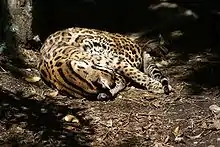
Animals on exhibit
Marge Schott/Unnewehr Elephant Reserve
P&G Discovery Forest
Wildlife Canyon (formerly)
- Sumatran rhinoceros
- Capybara
- Emu
- White-tailed deer
- Elk
- Wild yak
- Domestic yak
- Dall sheep
- Sichuan takin
- Red river hog
- Visayan warty pig
- Przewalski's horse
- Bactrian camel
Eagle Eyrie
- Steller's sea eagle
- Andean condor
- California condor
- Cinereous vulture
- Golden eagle
- White-rumped vulture
- Eurasian griffon vulture
- White-headed vulture
- Red-tailed hawk
- Harris's hawk
- Common raven
- American crow
- Greater yellow-headed vulture
- Lesser yellow-headed vulture
- Turkey vulture
- American black vulture
Reptile House
- Chinese alligator
- Saltwater crocodile
- Galápagos tortoise
- King cobra
- Brazilian rainbow boa
- Gaboon viper
Gorilla World
- Western lowland gorilla
- Black-and-white colobus
- Crested mona monkey
- Bonobo
- Long-wattled umbrellabird
Night Hunters
- Eurasian eagle owl (formerly)
- Spectacled owl
- Fossa
- Aardwolf
- Potto
- Pygmy slow loris
- Vampire bat
- Aardvark
- Northern greater galago
- Giant fruit bat
- Pallas cat
- Clouded leopard
- Siberian lynx
- Ocelot
- Sand cat
- Black-footed cat
- Bobcat
- Fishing cat
- Caracal
- Bearcat
- Tayra
- Bat eared fox
- Fennec fox
- Large spotted genet
- Banded palm civet
- Burmese python
Cat Canyon
- Cougar
- White tiger (formerly)
- Snow leopard
- Malayan tiger
- Jaguar
Monkey Island (formerly)
World of the Insect
Dragons
Lemur Lookout
Otto M. Buddig Manatee Springs
- Florida manatee
- Gray whale
- Orca
- Commerson's dolphin
- Alligator snapping turtle
- Alligator gar
- American alligator
- American crocodile
Siegfried and Roy's White Lions and George's Aviary
- White lion
- Blue iguana
- African sacred ibis
- American wood ibis
- Blue-footed booby
- Masked booby
- Brown booby
- Northern gannet
- Common kingfisher
- Milky stork
- Yellow-billed stork
- Painted stork
- Jabiru
- Lesser adjutant
- Greater adjutant
Rhino Reserve
- Eastern black rhinoceros
- Indian rhinoceros
- Plains zebra
- Okapi
- Bongo
- Yellow-backed duiker
- Greater flamingo
- Abdim's stork
- Bar-headed goose
Spaulding Children's Zoo
- Gopher tortoise
- Radiated tortoise
- Red-footed tortoise
- Southern three-banded armadillo
- Six-banded armadillo
- Nine-banded armadillo
- Common warthog
- Common peacock
- Java green peacock
- Parma wallaby
Gibbon Islands
Swan Lake
Wolf Woods
- Mexican wolf
- Grey fox
- California sea lion (formerly)
- Harbor seal (formerly)
- North American river otter
Lords of the Arctic
- Polar bear
- Arctic fox
- American black bear (formerly)
- Spectacled bear
Jungle Trails
- Sumatran orangutan
- Pileated woodpecker
- Coquerel's sifaka
- Müller's gibbon
- Aye-aye
- Angolan colobus monkey
- White-faced saki
- Grey bamboo lemur
- Laughing kookaburra
- Victoria crowned pigeon
- Greater rhea
- Koala
- Common wombat
- Southern cassowary
- Darwin's rhea
- Green iguana
Dobsa Giraffe Ridge
Africa
- African lion
- Impala
- Thomson's gazelle
- Lesser kudu
- White bearded wildebeest
- Crested guineafowl
- American flamingo
- Lesser flamingo
- Helmeted guineafowl
- Vulturine guineafowl
- Brown pelican
- Peruvian pelican
- Australian pelican
- Pink-backed pelican
- Dalmatian pelican
- Spot-billed pelican
- Ostrich
- Southern white rhinoceros
- Rüppell’s griffon vulture
- Lappet-faced vulture
Painted Dog Valley
Hippo Cove
Animals at the zoo have held several records, including the longest living American alligator in captivity at the time (at about 70 years of age),[5] the fastest cheetah in captivity,[14] and the largest Komodo dragon. The zoo was the first in the United States to put an aye-aye on display, and after losing its last aye-aye in 1993, it finally acquired another in 2011 – a six-year old transferred from the Duke Lemur Center in North Carolina.[15]
The zoo is one of only a dozen in North America to house and breed bonobos (also known as pygmy chimpanzees), an endangered species of the great apes.[16]
On January 6 and 7, the zoo celebrated the birth of its first babies of 2020. Two penguin chicks hatched, one each day.[17]
In August 2020, the Cincinnati Zoo finished the first part of their master plan "More Home To Roam". They turned their old wildlife canyon exhibit into an exhibit called Roo Valley, which has a new beer garden and restaurant, a big rope course over the habitat, and provides a new bigger home for their little blue penguins. Roo Valley adds five new species to the zoo as well, including the red kangaroos, western grey kangaroos, Australian wood ducks, New Zealand scaups and freckled ducks, the latter three species living side by side with the zoo's penguins.
In September 2020, the Cincinnati Zoo finished the second part of the master plan. They turned their old sea lion habitat sometimes referred to as "Seal Falls" and the home of Duke the California sea lion, into a bigger exhibit for their African penguins, increasing their breeding success rate, while at the same time including some other African sea birds like the eastern white pelicans, white-breasted cormorants, and yellow-billed ducks.
Center for Conservation and Research of Endangered Wildlife (CREW)
The Cincinnati Zoo has been active in breeding animals to help save species, starting as early as 1880 with the first hatching of a trumpeter swan in a zoo, as well as four passenger pigeons. This was followed in 1882 with the first American bison born in captivity.[5]
In 1986, the zoo established the Carl H. Lindner Jr. Family Center for Conservation and Research of Endangered Wildlife for the purpose of using science and technology to understand, preserve, and propagate endangered flora and fauna and facilitate the conservation of global biodiversity.[1] Its Frozen Zoo plays a major role. In it are stored over 2,500 specimens representing approximately 60 animal and 65 plant species. Terri Roth is CREW's director.[18]
Africa exhibit
In the 2010s the zoo built a 8-acre (3.2 ha) Africa exhibit, the largest animal exhibit in its history.[19] Phases I and II, completed in 2010, added an exhibit for cranes and expanded the Cheetah Encounter yard so that the cheetahs had a 40% larger running space.[20] Phase III opened on June 29, 2013, and included a wider vista that offers visitors an opportunity to see African lions, white lions, servals, a bat-eared fox, African wild dogs, and a new cheetah exhibit.[21] A new Base Camp Café, said to be the greenest restaurant in the US, was also added in the 2013 season.[22]
Phase IV, the largest phase of the Africa expansion, opened on June 28, 2014.[23] It introduced a wide savanna with some of Africa's most spectacular hoofstock, such as zebras, gazelles, lesser kudu, impala and giant eland, along with some of the world's largest birds like ostriches, marabou storks, pink-backed pelican, Rüppell's vultures, crested guineafowl, ruddy shelducks, lappet-faced vultures, and gray crowned cranes.
Phase V, the final phase of the expansion, opened on July 23, 2016,[24] adding an area for Nile hippos, Hippo Cove, which provides both above and below-water viewing.[23] A 34-year-old male named Henry from the Dickerson Park Zoo and a 17-year-old female named Bibi from the St. Louis Zoo joined the zoo.[25] On the morning of January 24, 2017, Bibi gave birth to a six-weeks premature calf.[26] The baby female hippo, named Fiona by zoo staff, is the first hippo to be born at the zoo in 75 years. Fiona was also the first Nile hippo to ever be captured on an ultrasound image. After intensive care from zoo keepers, veterinarians, and NICU specialists at Cincinnati Children's Hospital, Fiona survived. The story of her trials and success made her an internet celebrity and city hero, and has dramatically increased zoo attendance.[27] Henry's health declined later in 2017 and he was euthanized on October 31.[25]
On July 17, 2017, an eastern black rhino baby, Kendi, was born to parents Faru and Seyia. Kendi's birth was captured on camera and can be viewed on the zoo's website. Curator of mammals at the zoo, Christina Gorsuch states, "This calf is only the fifth eastern black rhino born in the last two years in North America." She goes on to say "Every rhino calf born is incredibly important for the population, which includes fewer than 60 in North America. Calves will stay with their mothers for 3-4 years which means that the average female can only have one calf every 5 years." [28] In 2015, AZA and Species Survival Plan (SSP) determined that parents Faru and Seyia were a good genetic match and recommended that they breed. Faru came to Cincinnati from Atlanta in the summer of 2015 and was introduced to Seyia.
Gorilla World was further expanded in 2016–2017, including the addition of a large indoor building to allow visitors to see the gorillas throughout the year, and Mshindi, a silverback gorilla, came to the zoo from the Louisville Zoo.[29][30]
Susie
.jpg.webp)
In 1931, Robert J. Sullivan permanently loaned the zoo a female eastern gorilla named Susie.[31] Captured in the Belgian Congo, Susie was first sold to a group of French explorers who sent her to France.[31] In August 1929, Susie was transported from Europe to the United States aboard the airship Graf Zeppelin accompanied by William Dressman.[31] After Susie completed a tour through the United States and Canada with Ringling Bros. and Barnum & Bailey Circus,[32] Sullivan purchased Susie for $4,500[33] and loaned her to the zoo.[34] Dressman, who stayed on as Susie's trainer after she was loaned to the zoo, taught her how eat with a knife and fork and orchestrated two performances every day.[35] Susie was so popular that on her birthday on August 7, 1936, more than 16,000 visitors flocked to the zoo.[36] Susie remained one of the most popular animals at the zoo until her death on October 29, 1947.[37] Her body was donated to the University of Cincinnati,[33] where her skeleton remained on display until it was destroyed in a fire in 1974.[38][39]
2016 gorilla incident
On May 28, 2016, Harambe, a 17-year-old, 200-kilogram (440 lb) male western lowland gorilla, was fatally shot by zoo officials after a three-year-old boy climbed into Harambe's enclosure. The incident was recorded by a bystander and uploaded to YouTube, where the video went viral.[40] Zoo director Thane Maynard stated, "The child was being dragged around ... His head was banging on concrete. This was not a gentle thing. The child was at risk."[41][42][43] The shooting was controversial,[44] with some observers stating that it was not clear whether or not Harambe was likely to harm the child.[45][46] Others called for the boy's parents and/or the zoo to be held accountable for the gorilla's death.[47]
The boy was transported to the hospital with non-life-threatening injuries after being rescued.[44] Police are investigating possible criminal charges, while the parents of the boy defended the zoo's actions.[48][49][50] The incident received global publicity; comedian and actor Ricky Gervais, rock guitarist and astrophysicist Brian May, and journalist and television personality Piers Morgan criticized the shooting,[51] while real estate developer and Presidential candidate Donald Trump and zoo director and notable animal expert Jack Hanna both lamented the shooting but defended the zoo's decision to prioritize the boy's safety.[52] Primatologist Frans de Waal neither defended nor condemned the zoo's decision, but described it as a horrible dilemma.[53]
Fiona
.jpg.webp)
In January 2017, the zoo had its first birth of a hippopotamus in 75 years. Named Fiona, she was born six weeks prematurely and her survival was in doubt. The zoo's efforts to save her and her subsequent improvement to good health provided a viral sensation on the internet.[54]
"More Home to Roam" expansion campaign
In 2018 the zoo launched an expansion campaign named "More Home to Roam" with the goal of raising $150 million to be used on developing new attractions and infrastructure.[55] The zoo plans to open Roo Valley and a beer garden in 2020, Rhino Reserve and a 1,800 vehicle parking garage in 2023, and Elephant Trek (Jabiru Junction) in 2025 for their jabirus.[56] The plan also includes a new entrance to facilitate traffic into the zoo. The additions are also aimed at making the zoo net-zero in terms of waste, water, and energy, making the facilities waste free.[56]
Philanthropists Harry and Linda Fath contributed $50 million to the campaign in June 2018.[57] Previous expansion efforts, such as the Africa exhibit and gorilla exhibit, cost $34 million and $18 million respectively.[58]
See also
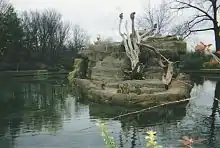
References
- "History, Mission, and Vision". cincinnatizoo.org. Cincinnati Zoo. Retrieved July 22, 2011.
- Baird, David; et al. (February 17, 2009). Frommer's USA. John Wiley & Sons. p. 491. ISBN 9780470458938. Retrieved May 9, 2013.
- "Currently Accredited Zoos and Aquariums". aza.org. AZA. Retrieved September 4, 2011.
- "Zoos and Aquariums of the World". waza.org. WAZA. Retrieved September 4, 2011.
- "Cincinnati Zoo". cincinnativiews.net. Don Prout. Retrieved July 22, 2011.
- "The last Carolina Parakeet". John James Audubon Center at Mill Grove. December 22, 2015. Retrieved October 30, 2018.
- "Best US Zoos: 10Best Readers' Choice Travel Awards". 10best.com. Retrieved September 24, 2018.
- "Best zoo in North America? Readers choose Cincinnati Zoo & Botanical Garden". USA Today 10 Best. USA Today.
- Gale, Oliver M. (Summer 1975). "The Cincinnati Zoo: 100 Years of Trial and Triumph" (PDF). Cincinnati Historical Society Bulletin. 33 (2): 86–119 – via Cincinnati History Library and Archives.
- Rolfes, Steven (October 29, 2012). Cincinnati Landmarks. Arcadia Publishing. p. 89. ISBN 9780738593951. Retrieved May 19, 2013.
- Painter, Sue Ann (2006). Architecture In Cincinnati. Ohio University Press. ISBN 0-8214-1701-0.
- Solski, Leszek (2006). "The Zoo and Aquarium Guide Book: Its Evolution and Uncertain Future". International Zoo News. 53 (5): 260–273.
- "Cincinnati Zoo and Botanical Garden - Ohio History Central". www.ohiohistorycentral.org. Retrieved November 4, 2018.
- "Every Day is Amazing at the Cincinnati Zoo". cincinnatizoo.org. Cincinnati Zoo. Archived from the original on August 20, 2011. Retrieved July 23, 2011.
- "Zoo's babies are a year-round thing". news.cincinnati.com. Cincinnati.com. Retrieved July 23, 2011.
- Bray, Shasta. "Re-interpreting Jungle Trails to Engage Families". Cincinnati Zoo Blog. Retrieved February 29, 2012.
- "WATCH: First zoo babies of 2020 arrive with birth of penguin chicks". fox19.com. Retrieved January 30, 2020.
- Steigerwald, Shauna (November 28, 2016). "Ipuh the rhino makes science, history and grandkids". The Enquirer. Retrieved October 4, 2018.
- Africa Exhibit Website
- "Phase 1 of Africa Savannah Opens Saturday". Retrieved June 10, 2013.
- "Ohio zoo readies Africa exhibit". Archived from the original on October 22, 2013. Retrieved June 10, 2013.
- "Cincinnati Zoo's restaurant greenest in United States". USA Today. June 7, 2013. Retrieved June 10, 2013.
- "Painted Dog Valley Now Open at the Cincinnati Zoo". Retrieved September 12, 2014.
- "Cincinnati Zoo opens new $7.5 million hippo exhibit". Springfield News-Leader. Associated Press. July 23, 2016.
- "Cincinnati Zoo Mourns Loss of Henry the Hippo". Cincinnati Zoo and Botanical Garden blog. October 31, 2017.
- "Hippo Baby Arrives Six Weeks Early". Cincinnati Zoo and Botanical Garden blog. January 24, 2017. Retrieved February 2, 2017.
- "Meet Fiona, the Cincinnati Zoo's $2,000 Baby Hippo". moneyish.com. July 20, 2017. Retrieved August 18, 2017.
- "Rare Glimpse of Cincinnati Zoo Rhino Birth and First Wobbly Steps Caught on Video! - The Cincinnati Zoo & Botanical Garden". The Cincinnati Zoo & Botanical Garden. July 18, 2017. Retrieved February 1, 2018.
- "Cincinnati Zoo gorilla exhibit scheduled to reopen in June". Cleveland: Fox 8. Associated Press. May 21, 2017.
- Sullivan, Mallorie (September 14, 2017). "Meet the Cincinnati Zoo & Botanical Garden's new gorilla, Mshindi". The Cincinnati Enquirer. Retrieved October 31, 2017.
- Joy W. Kraft, The Cincinnati Zoo and Botanical Garden, (Charleston, SC: Arcadia Pub, 2010), 72.
- “Susie, Cincy Zoo’s Gorilla, Near Death,” The Billboard 59, no. 43 (November 1, 1947): 57.
- "Cincy Zoo’s Susie Dies; Local Paper Plans Replacement," The Billboard 59, no. 44 (November 8, 1947): 53.
- Joy W. Kraft,The Cincinnati Zoo and Botanical Garden, (Charleston, SC: Arcadia Pub, 2010), 72-74.
- Ohio Writers' Program, Cincinnati; A Guide to the Queen City and Its Neighbors, (Cincinnati: Wiesen-Hart Press, 1943), 350.
- ”8,000 at Cincinnati Attend Party for Susie, the Gorilla,” The Milwaukee Journal, August 3, 1936: 8.
- Joy W. Kraft,The Cincinnati Zoo and Botanical Garden, (Charleston, SC: Arcadia Pub, 2010), 72-75.
- Joy W. Kraft,The Cincinnati Zoo and Botanical Garden, (Charleston, SC: Arcadia Pub, 2010), 76.
- Newman, James L (2013). Encountering gorillas: a chronicle of discovery, exploitation, understanding, and survival. Lanham, Maryland, US: Rowman & Littlefield. pp. 117–118. ISBN 978-1-4422-1957-1.
- Cincinnati zoo kills gorilla to save boy who fell into enclosure on YouTube
- McPhate, Kate (May 30, 2016). "Zoo's Killing of Gorilla Holding a Boy Prompts Outrage". New York Times. Retrieved May 31, 2016.
- Ralph, Ellis; Rose, Rashard (May 29, 2016). "Gorilla shot to save child at Cincinnati zoo". CNN. Retrieved May 30, 2016.
- "Gorilla Killed After Child Enters Enclosure at Cincinnati Zoo". The New York Times. May 30, 2016. Retrieved May 30, 2016.
- "Zoo faces backlash over decision to shoot gorilla dead after boy, 4, fell into enclosure". Evening Standard. May 29, 2016. Retrieved May 30, 2016.
- "Killed Gorilla Seemed to Protect Child Who Fell in Enclosure: Witness". NBC News. Retrieved May 30, 2016.
- "Gorilla shot dead in zoo: Killing unnecessary, primate expert says - Video". NewsComAu. May 30, 2016. Retrieved May 30, 2016.
- Grinberg, Emanuella (May 29, 2016). "Critics blame parents, Cincinnati Zoo for gorilla's death". CNN. Retrieved May 31, 2016.
- "Gorilla killing at Cincinnati zoo sparks probe into possible criminal charges". Reuters. June 2016.
- "Mother of boy who fell into zoo enclosure lashes out at critics". News Corp.
- John Shammas (June 1, 2016). "Astonishing new footage shows gorilla 'PROTECTING' boy and holding his hand before being shot dead".
- Chris Graham (May 31, 2016). "Celebrities joins backlash over shooting of Harambe the gorilla - but Ohio zoo defends decision". Daily Telegraph. Retrieved May 31, 2016.
- Eliana Dockterman (May 31, 2016). "Donald Trump Defends Cincinnati Zoo's Shooting of Harambe the Gorilla". Time. Retrieved May 31, 2016.
- Frans De Waal (May 30, 2016). "Leading Primatologist Frans de Waal Weighs in on Controversy Surrounding Harambe, Gorilla Shot at Zoo". AlterNet. Retrieved May 31, 2016.
- Kevin Tidmarsh (July 24, 2017). "While Fighting The Odds, Fiona The Hippo Became A Social Media Star". Morning Edition. NPR.
- "Cincinnati Zoo to transform habitats with $50 million donation". daytondailynews. Retrieved October 7, 2018.
- "Cincinnati Zoo to Open New Australia-Themed Area". CityBeat Cincinnati. Retrieved October 7, 2018.
- Brunsman, Barrett J. (June 7, 2018). "Cincinnati businessman gives $50M to zoo". www.bizjournals.com. Retrieved November 5, 2018.
- "Meet Harry and Linda Fath. They just made the biggest donation ever to the Cincinnati Zoo". Cincinnati.com. Retrieved October 17, 2018.
External links
| Wikisource has the text of the 1920 Encyclopedia Americana article Cincinnati Zoological Gardens. |
 Media related to Cincinnati Zoo and Botanical Garden at Wikimedia Commons
Media related to Cincinnati Zoo and Botanical Garden at Wikimedia Commons- Official website
- Cincinnati Zoo & Botanical Garden on zooinstitutes.com